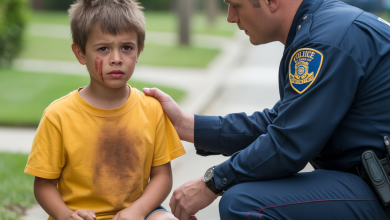The Pilots Fainted at 33,000 Feet. The 12-Year-Old Boy in Seat 14A Was Their Only Hope.
The flight was a dream come true for 12-year-old Leonard Thompson. An aviation enthusiast who spent his nights studying flight manuals and his weekends mastering a home flight simulator, this trip was more than a vacation; it was a pilgrimage.
As the Boeing 737 roared to life and lifted into the sky, he was ecstatic, his face pressed against the window, his mind cataloging every sound and sensation. He had no way of knowing that before the flight was over, his bedroom hobby would be pitted against a real-life, high-stakes disaster, and the lives of every person on board would depend on him.
The first sign of trouble was the turbulence. It started as a few gentle bumps, but quickly escalated into violent jolts that sent gasps of fear through the cabin. Oxygen masks dropped from the ceiling. Alarms, shrill and terrifying, began to blare from the direction of the cockpit. But amidst the chaos, Leonard noticed something even more frightening: the silence. He knew from his studies that in an emergency, the pilots should be communicating. But after one tense, brief announcement, there was nothing. A chilling, unnatural quiet emanated from behind the cockpit door.
“Mom, something’s wrong,” he said, his voice tight with a fear born of knowledge. “They should be talking to us.”
His observation, and his insistence, convinced a panicked flight attendant to use the emergency code to open the cockpit door. The scene they discovered was a nightmare realized: both the pilot and the co-pilot were slumped over in their seats, unconscious. The plane was in a steep, uncontrolled descent. No one was flying the plane.
In that moment of sheer terror, the shy, quiet 12-year-old boy from seat 14A stepped forward. “I know how to work the basic controls,” he said, his voice trembling but determined. “It’s our only chance.” Leaving his terrified mother behind, he walked into the chaotic cockpit, a symphony of flashing warning lights and deafening alarms. He slid into the co-pilot’s seat, took a deep breath, and grabbed the microphone. “This is Leonard Thompson, a passenger,” he transmitted, his voice shaky. “Both pilots are unconscious. I’m in the cockpit, and the plane is descending rapidly. I need help.”
On the other end of the line, a calm, steady voice from Miami Air Traffic Control became his lifeline. Guided by this unseen hero on the ground, Leonard began the impossible task of saving the aircraft. He pulled back on the heavy control yoke, fighting the plane’s terrifying descent. He located the throttles and carefully reduced the dangerously high speed. But as soon as one problem was solved, another erupted.
A new alarm signaled a hydraulic system failure. The controller talked him through activating the manual backup, but the consequences were dire. “Control, what about the landing gear?” Leonard asked, his knowledge of the systems now a source of terror. “It’s hydraulic too, isn’t it?” The answer was yes. The landing gear would not deploy automatically.
As if that weren’t enough, the spoilers malfunctioned, and the plane was flying through a storm with near-zero visibility. The final approach to Miami would have to be done blind, relying only on the instruments and the voice on the radio. The greatest challenge came with the landing gear. The controller instructed Leonard to use the manual override, a hand crank that had to be turned repeatedly with immense physical effort. With the flight attendant helping him, the skinny 12-year-old poured every ounce of his strength into the lever, his arms aching, until a loud, metallic click echoed through the cockpit. A green light illuminated. The gear was down.
The final moments of the flight were a blur of intense focus. Guided by the controller’s precise instructions, Leonard navigated the massive plane through the thick clouds, his eyes darting between the artificial horizon and the airspeed indicator. “Trust your instruments,” the voice on the radio urged. “You can do this.”
Suddenly, the runway lights appeared through the fog, closer than he expected. With the controller’s voice in his ear, he flared the plane, keeping the nose slightly elevated. The main gear hit the tarmac with a jarring thud, sending a violent shudder through the plane, followed by the roar of the thrust reversers. The aircraft raced down the runway before finally, miraculously, coming to a complete stop.
For a moment, there was absolute silence. Then, the cabin erupted in cheers and sobs of relief. Leonard let go of the yoke, his hands trembling uncontrollably. He had done it. He had saved them all. Hailed as a global hero, the shy boy wanted none of the fame. The terrifying experience had simply forged his lifelong passion for flying into a true calling. The boy who saved a plane by acting like a pilot was now, more than ever, determined to one day earn his wings for real.




